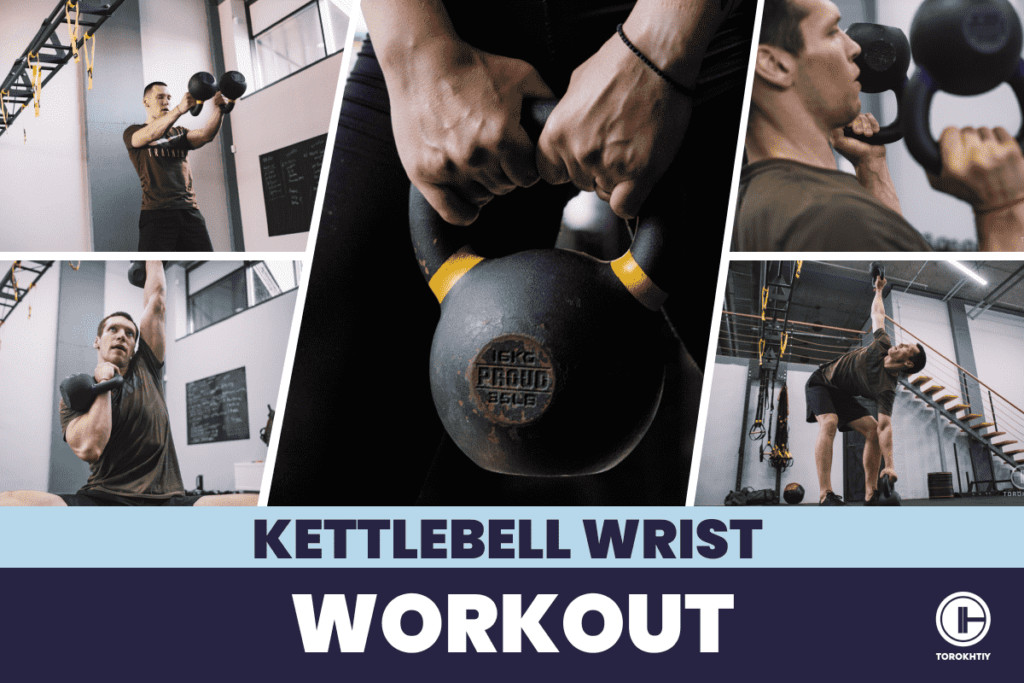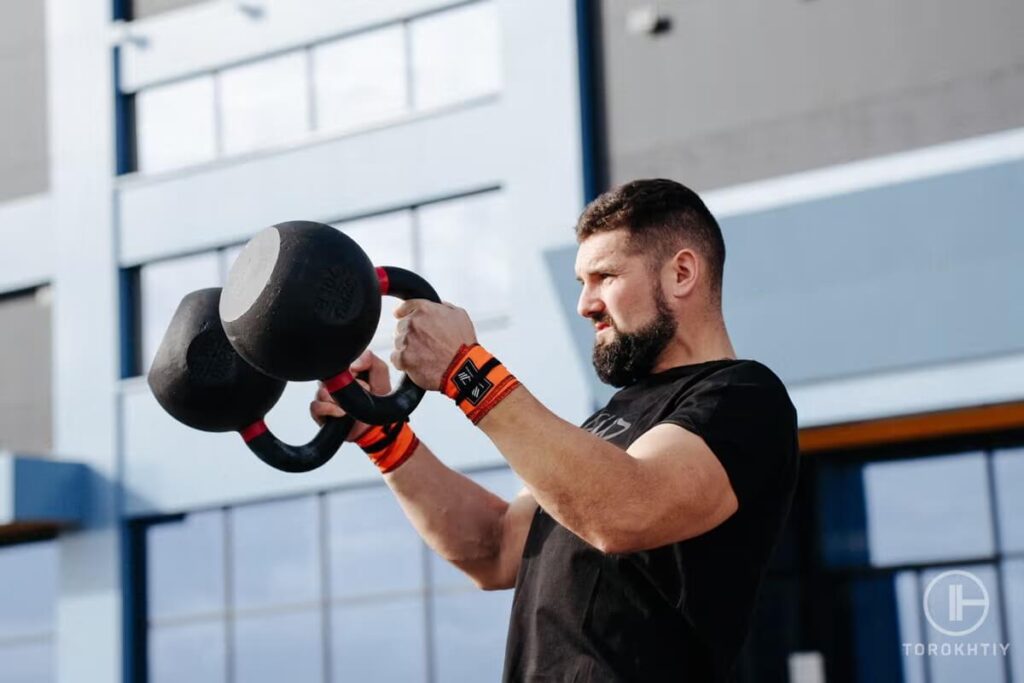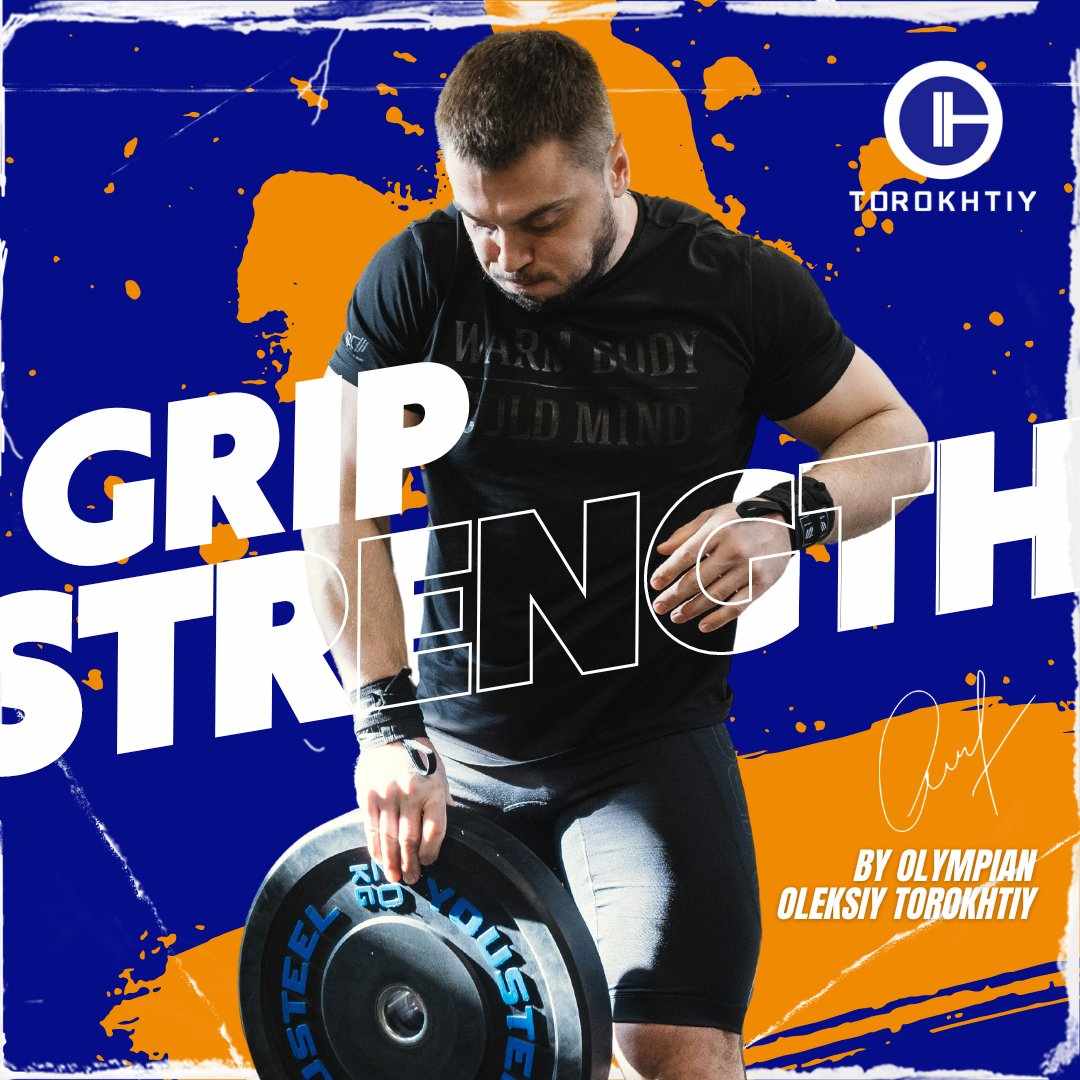Master Grip and Wrist Strength with Kettlebell Wrist Workout
Author:
Reviewed by:
(21 years of Oly Lifting experience)
Unlock your full potential by engaging with our experts and community! Have questions about your fitness journey or looking for expert advice on weightlifting techniques? Don’t hesitate — leave a comment below and Sergii Putsov will provide a personalized answer and insights to help you reach your goals.
Torokhtiy is reader-supported. Some links are affiliate links, and we may earn a commission at no extra cost to you. See our disclosure page for details.
Think of kettlebells like dumbbells’ siblings. They’re in the same family, you see why they’re related, but they’re still different. Kettlebells are just as popular as dumbbells because they’re very versatile and effective. They can be used for all sorts of exercises, but today, we’re focusing on the kettlebell wrist workout. If you’re not using kettlebells to strengthen your grip and wrists, you’re missing out, and we’ll show you why.
Imagine yourself being really focused on your workout, everything’s going well but all of a sudden, you feel the strain in your arms and your wrists start to falter. It won’t ruin your workout, but it will annoy you like crazy. We’ve all been there, but the good news is, there are ways of preventing that from happening, all you need to do is work on your grip and strengthen your wrists.
We’ll go through the most effective kettlebell grip strength exercises you can do, what are the most important principles to keep in mind, and how to build a comprehensive workout routine.
What is a kettlebell wrist workout? Kettlebell wrist workout involves doing different exercises with a kettlebell to strengthen and stabilize the muscles in the wrists and forearms. Some of these exercises are wrist curls, rotations, and holds, all targeting both strength and flexibility.

How to Get Strong Grip/Wrist with Kettlebells?
Instead of beating about the bush, we’ll get right into why you’re here for – how to use kettlebells to get a strong grip and wrists. There’s a chance you think kettlebells are used just for swinging and lifting, but they can do a lot more than that.
Want Healthy and Strong Wrist – Get a Strong Grip
Before getting into the specific kettlebell wrist exercises, it’s important to understand that there’s a connection between how healthy your wrists are and how strong your grip is. The grip is a foundational element for overall wrist stability and function. Think of your wrist as the bridge between your hand and forearm muscles; when you grip something, the muscles in your hands and forearms engage and exert force through the joint. The stronger your grip, the better equipped your wrists are to withstand this force, which can reduce the risk of injury.
There’s a ton of research on grip strength out there and it shows a direct link between grip strength and overall health and longevity. Most people who have strong grips are well-trained, so it makes sense that they have less health issues. Research has also shown that there’s a link between grip strength and cardiovascular health, muscle mass, and foundational independence in older adults, so no matter the age, strong grip and wrists are a must.
Train with Kettlebells; Kettlebell = Grip Strength
The movements you do with a kettlebell are dynamic and engage multiple muscle groups at the same time so, although your focus may be your forearms and wrists, the rest of your body is working, too.
When you hold a kettlebell, the weight is evenly distributed, which means your grip and wrist muscles need to work harder to maintain control and stability. This constant demand for grip strength throughout kettlebell exercises will help strengthen your hands and the muscles and tendons in your wrists and forearms.
The best thing about this type of training is that you can customize it, so whatever your fitness level, you can make it work for you. Plus, you can make any changes you need to target specific areas of weakness or imbalance in your grip and wrists.
1. Snatch
This is a dynamic, explosive, full-body movement that will target both your major muscle groups and challenge the strength of your grip and wrists.
Start with the kettlebell on the ground, between your feet. Hinge at the hips, bend at the knees, and grab the kettlebell with one hand. Then, explosively extend your hips and knees in one smooth motion while pulling the kettlebell up at the same time. As the kettlebell reaches your shoulder height, quickly rotate your hand, and punch it overhead, locking your arm.
The snatch targets your posterior chain mostly, but because of its dynamic nature, it needs your grip and wrist muscles to work really hard to keep the kettlebell under control. If you do snatches repeatedly (with proper form of course), you’ll improve explosive power, cardiovascular endurance, and you’ll also develop a strong grip and wrists.
2. Clean
Much like the snatch, the kettlebell clean is a powerful movement that challenges your grip and wrist stability while targeting major muscle groups.
You’ll start with the kettlebell on the ground in front of you. With a firm grip, hinge at the hips and bend your knees to lower into an almost squat position. Explosively extend your hips and knees while pulling the kettlebell up at the same time. As the kettlebell reaches your shoulder, quickly tuck your elbow and “catch” the kettlebell at shoulder height. Make sure your wrists stay aligned with your forearm.
You might be thinking to yourself, “Hey, that sounds like my quads, hamstrings, glutes, and upper back are doing all the work!” And that’s true, the clean targets mostly those muscles, but the pull and catch phase, where you catch the kettlebell at shoulder height, places a significant demand on your grip and wrist strength. When you master the clean and start gradually increasing the weight, it will strengthen your wrists and grip.
3. Swing
A fundamental exercise, the kettlebell swing will strengthen your posterior chain and challenge the stability of your grip and wrists.
Stand with feet a little bit wider than shoulder-width apart and grab the kettlebell with both hands. Hinge at the hips and allow the kettlebell to swing back between your legs. Explosively drive your hips forward to generate momentum to swing the kettlebell up until it reaches your chest height.
This fast acceleration and deceleration of the kettlebell during the swing requires your grip and wrist muscles to contract really hard to keep the kettlebell under control, which is what ultimately makes it such a good exercise for strengthening your grip and wrists.
4. TGU (Turkish Get-Up)
The TGU is rather complex compared to the other exercises on this list. It’s multi-dimensional and challenges your strength, stability, and coordination. At the same time, it places a great demand on the strength of your grip and wrists.
To do the Turkish get-up, lie down on your back with the kettlebell next to you. Grab the handle with one hand and press it, locking out your arm. With the opposite arm extended to the side, bend your knee on the same side and roll onto your opposite elbow. From here, push through your hand to elevate your torso into a seated position, then go to a kneeling position and finally stand up while keeping the kettlebell over your head.
This exercise engages a lot of muscle groups throughout your entire body, but it’s also really good for grip and wrist strength. The constant stabilization that’s needed to keep the kettlebell over your head makes your grip and wrists work extra hard, so over time, it can help you strengthen both.
Follow us!

Free!
Get a 2-week Weightlifting Program as a bonus for the subscription to kickstart your training plan!

Free!
2 Isolated Kettlebell Wrist and Forearm Exercises
Compound movements should have a place in everyone’s training routine. They engage multiple muscle groups at the same time, so you get an effective, time-efficient workout. But if you’re trying to focus on one area specifically (in this case, the wrists), you’ll want to include some isolated exercises that will target this area directly.
1. Wrist and Reverse Wrist Curls
These two exercises are superstars when it comes to strengthening your wrists and they’re extremely simple to do. Just sit on a bench or chair with your forearm resting on your thigh, palm facing up, and holding a kettlebell with an overhand grip. Slowly curl your wrist up and bring the kettlebell towards your body, then lower it back down in a controlled manner.
If you want to do reverse wrist curls, just reverse this exercise, and curl your wrists down. These target your wrist flexors and extensors and, when you do them consistently, you’ll strengthen these muscles and improve the stability of your wrists.
Tips From the Champ
If you want to give your wrists a little extra challenge (they’ll thank you for it later!), use a kettlebell with a thicker handle or you can wrap a towel around the handle. This will make the exercise harder on your grip and wrists, which leads to stronger wrists and forearms over time.
Olympic Weightlifting Champion
2. Wrist Rotations
This is another exercise that will improve the stability and mobility of your wrists.
Hold a kettlebell with an overhand grip in front of you at shoulder height, with your arm extended. Keep the elbow static and rotate the kettlebell in a circular motion, alternating between clockwise and counterclockwise rotations. Make sure to control the movement with your wrist and engage the muscles in your forearm through the entire range of motion. Do a few sets in each direction.
Wrist rotations, or kettlebell wrist turns, do a great job at targeting the muscles responsible for wrist stability and mobility, as well as the forearm flexors and extensors. They can improve the overall function of your upper body and you’ll experience noticeable improvements in the strength of your grip and wrists.
How to Grow Big and Strong Forearms?
How can you not want your forearms to be big and strong? They look great that way, right?
But you shouldn’t want big forearms just for the sake of aesthetics. They impact your strength, functionality, and they can improve your performance and the health of your wrists.
1. Progressive Overload
Anyone who’s ever wanted to do any kind of workout must have heard of progressive overload. It’s the key to progress and avoiding plateaus. Progressive overload means that you increase the demands that are placed on your muscles over time, which stimulates growth and adaptation. In really, really simple terms, it means that you make your exercises harder to do as you go along.

When it comes to making your forearms big, progressive overload can be increasing the weight, reps, and difficulty as your strength improves. Naturally, you’ll start with lighter weights and then increase the resistance little by little. This will keep your muscles constantly challenged.
2. Volume, Intensity, and Recovery
You want to balance volume (the total amount of work you do), intensity (the level of effort or resistance), and recovery. It sounds almost like an equation, but it’s actually pretty simple. The rule of thumb is to keep things challenging, but still manageable. Working out shouldn’t be pleasant and you need to feel some discomfort, but it shouldn’t be anything extreme. Mix high and low reps for the best results and don’t forget to include rest days into your training routine because your muscles need time to repair and grow.
Sample Kettlebell Training
If you’re ready to put your newfound knowledge to the test, we have a great routine to do that!
1. Warm-Up
Start with warming up for 5-10 minutes to get the muscles and joints ready for the workout. The warm-up can include dynamic stretches, light jogging, or mobility exercises.
Move to TGUs – 2 sets of 5-10 reps per side using a light weight to engage multiple muscle groups and improve joint stability.
2. Main Sets
Start with 2-3 sets of 8-10 reps or clean and press to challenge your grip and wrist stability while also building strength across your shoulders and upper body.
Follow this by 2-3 sets of 8-10 reps of lunges with a kettlebell. This will target your lower body and core, with an extra emphasis on balancing and stabilizing the weight as you move.
Finish with gorilla rows – 2-3 sets of 8-10 reps per arm. This rowing motion will improve the strength in your back and arms.
3. Finisher
Complete the workout with 100 single arm swings for time (change arm every 10 reps). This powerful finisher will boost your cardiovascular fitness, target your entire body, and particularly test your grip and endurance as you maintain control of the kettlebell.
Repeat this routine 2-3 times a week and don’t forget to cool down after each session!
Conclusion
And that would be it on using kettlebells to make your wrist stronger! There’s a lot of information here, but it really all comes down to common sense – your training routine should include both compound and isolation exercises, you should up the intensity gradually, and every move you make needs to be executed with proper form.
Don’t forget to rest for a day or two to let your muscles recover and to catch up on your favorite shows.
Now it’s your turn! Which of the wrist exercises with kettlebell mentioned above is your favorite and why? What do you think is the most effective way to get strong wrists? Do you have any other exercises to recommend?
Spill the beans in the comment section, we’re all ears! Well, not ears, eyes… You know.
Also Read:
- Best Kettlebell Exercises (With 3 Workout Examples)
- Are Adjustable Kettlebells Worth It?
- Kettlebells vs Barbells: Which One to Use?
- What Size Kettlebell Should I Get?
- How To Get Bigger Wrists: Growth Strategies & Exercises
- 6 Dumbbell Wrist Exercises for Strength and Stability
References:
- Becks Shepherd “Why are rest days important?” LiveScience, https://www.livescience.com/why-are-rest-days-important (accessed April 9th, 2024)
- Brad J. Schoenfeld, Jozo Grgic, Dan Ogborn, James W. Krieger “Strength and Hypertrophy Adaptations Between Low- vs. High-Load Resistance Training: A Systematic Review and Meta-analysis,” Journal of Strength and Conditioning Research 31, no. 12 (2017): 3508-3523.
- Gerrit Stassen, Lukas Baulig, Ole Müller, Andrea Schaller “Attention to Progression Principles and Variables of Exercise Prescription in Workplace-Related Resistance Training Interventions: A Systematic Review of Controlled Trials,” Frontiers in Public Health, March 25, 2022, Sec. Occupational Health and Safety, Volume 10 – 2022.
- Jake Depp, PT “Why a strong grip is important, and how to strengthen those muscles,” Ohio State Health & Discovery, https://health.osu.edu/wellness/exercise-and-nutrition/why-a-strong-grip-is-important (accessed April 9th, 2024)
- Richard W. Bohannon, “Grip Strength: An Indispensable Biomarker For Older Adults,” Clinical Interventions in Aging 14: 1681–1691, 2019.
- Photos made by Torokhtiy Media Team.
Why Trust Us?
With over 20 years in Olympic weightlifting, strength training, nutrition coaching, and general fitness our team does its best to provide the audience with ultimate support and meet the needs and requirements of advanced athletes and professional lifters, as well as people who strive to open new opportunities and develop their physical capabilities with us.
By trusting the recommendations of our certified experts in coaching, nutrition, and sports training programming, as well as scientific consultants, and physiotherapists, we provide you with thorough, well-considered, and scientifically proven content. All the information given in the articles concerning workout programming, separate exercises, and athletic performance, in general, is based on verified data.
The product testing process is described in more detail here.
Author: Sergii Putsov
Head of Sport Science, PhD
Best Results: Snatch – 165 kg,
C&J – 200 kg
Sergii Putsov, Ph.D., is a former professional weightlifter and National team member, achieving multiple medals in the 94 kg weight category at national competitions. With a Master’s degree in “Olympic & Professional Sport Training” and a Sport Science Ph.D. from the International Olympic Academy, Greece, Sergii now leads as the Head of Sport Science. He specializes in designing training programs, writing insightful blog articles, providing live commentary at international weightlifting events, and conducting educational seminars worldwide alongside Olympic weightlifting expert Oleksiy Torokhtiy.
Reviewed by: Oleksiy Torokhtiy
Olympic Weightlifting Champion, PhD in Sport Science
Best Results: Snatch – 200 kg,
C&J – 240 kg
Oleksiy Torokhtiy is a professional athlete boasting 20 years of experience in Olympic weightlifting. With multiple European and World titles under his belt, he has showcased his prowess in two Olympic Games (Beijing 2008 and London 2012). Upon concluding his illustrious career, Oleksiy dedicated himself to coaching. By 2022, he had conducted over 200 weightlifting seminars worldwide. He is the visionary behind an international sportswear and accessories brand known for its motto, “Warm Body Cold Mind.” Additionally, he is an esteemed author and the creator of a series of training programs and eBooks.






Still have questions after reading our article? Unlock your full potential by engaging with our experts and community! Don’t hesitate — leave a comment below and Sergii Putsov will provide a personalized answer and insights to help you reach your goals.